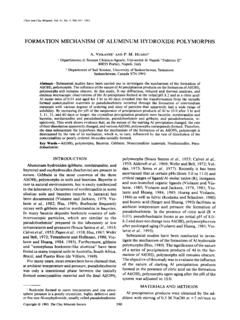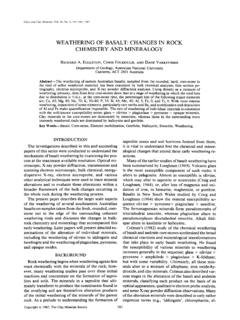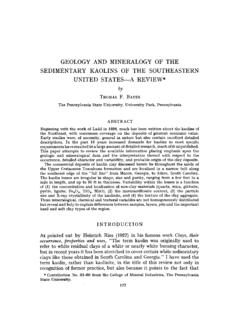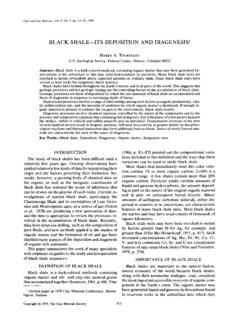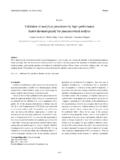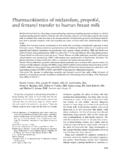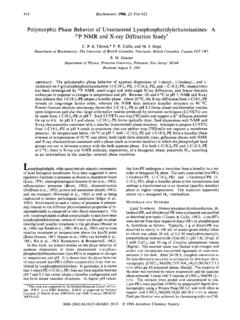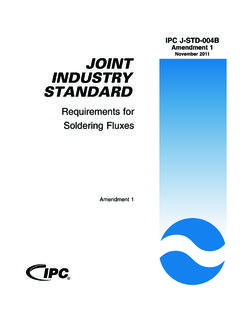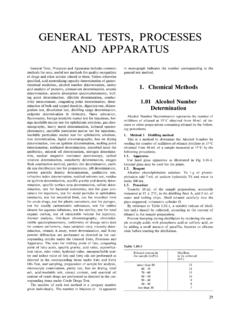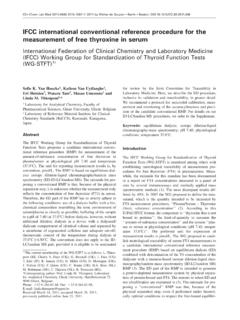Transcription of METHYL t-BUTYL ETHER (MTBE) PRODUCTION: A …
1 Clays and Clay Minerals, Vol. 34, No. 5,597-603, 1986. METHYL t-BUTYL ETHER (MTBE) production : A comparison OF montmorillonite - derived catalysts WITH AN ION-EXCHANGE RESIN J. M. ADAMS, K. MARTIN, R. W. MCCABE, AND S. MURRAY Edward Davies Chemical Laboratories, University College of Wales Aberystwyth SY23 lINE, United Kingdom Abstract-- montmorillonite -based catalysts were compared with an acidic ion-exchange resin of the type used industrially for the production of METHYL t-BUTYL ETHER (MTBE) from methanol and isobutene or t-butanol. When 1,4-dioxan was used as solvent, Al3+-exchanged montmorillonites had about half the efficiency of the resin Arnberlyst 15 at 60~ they were, however, about twice as efficient at this temperature at Ti3+- montmorillonite or K10, a commercially available acid-treated bentonite.
2 montmorillonite ex- changed with Chlorhydrol solutions to give interlayer [AI1304(OH)2(H20)12] 7+ ions and pillared clays derived from such materials were poor catalysts , as was K306, a more drastically acid-treated bentonite- based commercial catalyst. Freeze-drying of the AP+-day before reaction to produce a more open, porous structure had no effect on its catalytic efficiency. The activation energy for the reaction of isobutene and methanol in dioxan was 44 El/mole for an AP+-clay catalyst compared with 25 kJ/mole for reactions catalyzed by Ambedyst 15. With no solvent (as in industrial processes), the rates of reaction were considerably slower for both the clay- and resin-catalyzed reactions.
3 As has been found previously for resin-catalyzed reactions using stoichiometric amounts or an excess of methanol, the rate was proportional to the isobutene concentration, and the rate-determining step appeared to be protonation of the alkene. The performance of the AP+-clay catalyst was increased by reducing the water content of the clay. In most reactions the clay catalysts were equilibrated at 12% relative humidity. Exposure of the clay to a low vacuum (10-1 ton-) before use increased its catalytic activity from 50 to 60% of that of Amberlyst 15. Key Words--Amberlyst 15, Catalysis, Chlorhydrol, Ion-exchange resin, METHYL t-BUTYL ETHER , Montmo- rillonite.
4 INTRODUCTION METHYL t-BUTYL ETHER (MTBE) is an effective octane booster for unleaded gasolines (Csikos et al., 1975; Pecci and Floris, 1977; Nishizawa et al., 1974; Wa- tanabe et al., 1973). It also acts as a volume extender, by adding volume to the gasoline pool and by reducing the severity of the naphtha reforming and related con- version operations (Muddaris and Pettman, 1980). Industrial processes for the production of MTBE are based on liquid phase reaction of methanol with iso- butene over an acidic ion-exchange resin (Gupta and Prakash, 1980). Most of the processes are carried out between 35 ~ and 90~ lower temperatures favor more complete conversion and longer catalyst lives but lower reaction rates.
5 The process is conducted at the lowest pressures compatible with keeping the C4 feedstocks in the liquid state (100-200 psi). Ion-exchanged montmorillonites are acidic catalysts (Mortland and Raman, 1968), and Bylina et al. (1980) and Adams et al. (1982) reported that they can catalyze the production of MTBE from methanol and isobutene or from methanol and t-butanol (Adams et al., 1981) as follows: MeOH + CH2=C(C[--I3)2 --* Me-O--(2(CH3)3 MeOH + HOC(CH3) 3 ~ Me-O-C(CH3)3 + HaP. Copyright 9 1986, The Clay Minerals Society Moreover, methods have been described for the acid- treatment of montmorillonite -based catalysts and the addition of water to improve their ability to catalyze the production of MTBE (see , Gregory and West- lake, 1982, 1983).)]
6 In the present work the activity of several catalysts derived from a montmorillonite are compared with that of the macroreticular sulphonic acid resin Am- berlyst 15 (Anonymous, 1967) which is similar to the acidic resin used industrially for the production of MTBE (Ancillotti et al., 1977). Ancillotti et al. (1977, 1978) and Gicquel and Torck (1983) showed that at methanol:isobutene ratios reasonably close to unity the pore spaces of Ambeflyst 15 resin are filled with methanol, which acts as the solvent at the reaction site in the formation of MTBE. The methanol molecules pick up protons from the resin and become the catalytic agents.
7 The reaction shows first-order dependence on isobutene concentration; thus the rate determining step appears to be alkene protonation, + CH2=C\cH3 +/CH3 -~ CH3OH + CH3-C\ , CH3 to form the tertiary carbocation. 597 598 Adams, Martin, McCabe; and Murray Clays and Clay Minerals The majority of the catalysts studied in the present investigation were related to AP+- montmorillonite which is known to be highly acidic (Adams et al., 1983a, 1983b) and include AP+- montmorillonite , montmorillonite exchanged with the polycation [Alt304(OH)z4(HzO)lz] 7+, a pillared (A1203) clay (Vaughan and Lussier, 1980; Vaughan et aL, 1979, 1981), and two commercial acid-treated clays, K10 and K306 (Sfid-Chemie AG).
8 In addition, reactions with Ti3+- montmorillonite , a material having very high acidity for such catalysts (Morikawa et aL, 1983), were also investigated. All of these clay-based catalysts (in- cluding K10 and K306) were derived from clay from the same source. EXPERIMENTAL Catalyst characterization The bentonite used for most of this study came from Moos- burg, Federal Republic of Germany (Tonsil 13, Siid-Chemie AG). The <2-um clay fraction was prepared by sedimenta- tion. An X-ray powder diffraction (XRD) examination showed that this fraction was ~ 98% montmorillonite with ~ 2% quartz impurity.
9 An X-ray fluorescence (XRF) analysis gave SiO2, A1203, Fe203, TiO2, CaO, MgO, K20, and Na20. Loss on ignition was The cation-exchange capacity totaled 103 meq/100 g of air-dry material and consisted of 68, 33, and 2 meq/100 g of Na +, Ca 2+, and Mg 2+, respectively. montmorillonite from Upton, Wyoming, was used to study the dependence of reaction rate on concentration ofisobutene and methanol. Here also, sedimentation was carried out to separate the <2-urn fraction. Catalyst preparation To aid later cation-exchange processes, a large quantity of the Tonsil 13 clay was exchanged initially with Na +, The clay was added to an M solution of NaCI and heated to 70~ with vigorous stirring for 1 hr.
10 Two fractions were produced by sedimentation. The finer fraction was subjected to ultra- sonic treatment for 10 min, and the <2-urn fraction was collected by sedimentation. AP+- montmorillonite was prepared by exposing some of this <2-~m fraction to an M A1C13 solution (pH = ) for 24 hr. The clay was then centrifuged and resuspended in deionized water repeatedly until a test for excess salt proved negative. At this point the pH of the super'natant liquid was The clay was isolated by centrifugation, dried at 40~ and mechanically ground. The basal spacing of this clay was ~ and the aluminum content was higher than before aluminum exchange--a value correspondng to a cat- ion-exchange capacity (CEC) of 109 meq/100 g if the alu- minum is assumed to be present as A13+ monomers.


